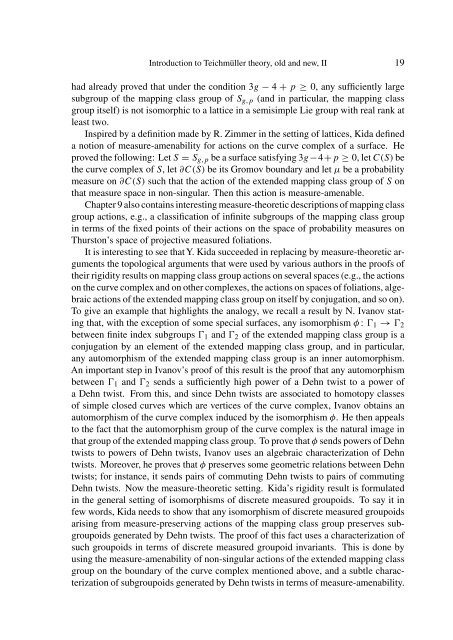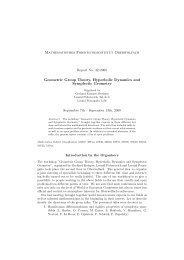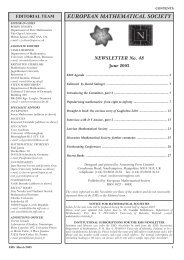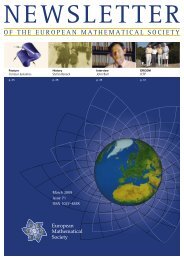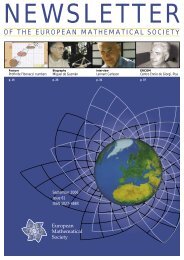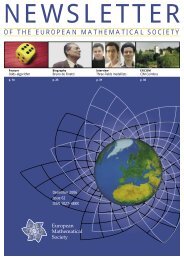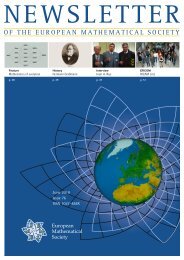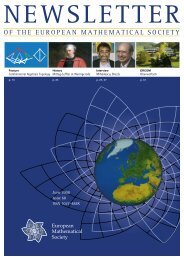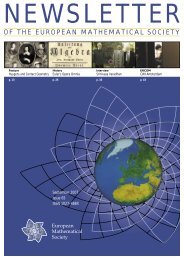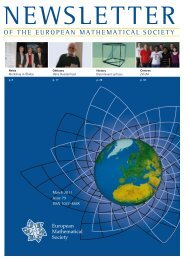Introduction to Teichmüller theory, old and new, II
Introduction to Teichmüller theory, old and new, II
Introduction to Teichmüller theory, old and new, II
Create successful ePaper yourself
Turn your PDF publications into a flip-book with our unique Google optimized e-Paper software.
<strong>Introduction</strong> <strong>to</strong> <strong>Teichmüller</strong> <strong>theory</strong>, <strong>old</strong> <strong>and</strong> <strong>new</strong>, <strong>II</strong> 19<br />
had already proved that under the condition 3g − 4 + p ≥ 0, any sufficiently large<br />
subgroup of the mapping class group of Sg,p (<strong>and</strong> in particular, the mapping class<br />
group itself) is not isomorphic <strong>to</strong> a lattice in a semisimple Lie group with real rank at<br />
least two.<br />
Inspired by a definition made by R. Zimmer in the setting of lattices, Kida defined<br />
a notion of measure-amenability for actions on the curve complex of a surface. He<br />
proved the following: Let S = Sg,p be a surface satisfying 3g −4+p ≥ 0, let C(S)be<br />
the curve complex of S, let ∂C(S) be its Gromov boundary <strong>and</strong> let μ be a probability<br />
measure on ∂C(S) such that the action of the extended mapping class group of S on<br />
that measure space in non-singular. Then this action is measure-amenable.<br />
Chapter 9 also contains interesting measure-theoretic descriptions of mapping class<br />
group actions, e.g., a classification of infinite subgroups of the mapping class group<br />
in terms of the fixed points of their actions on the space of probability measures on<br />
Thurs<strong>to</strong>n’s space of projective measured foliations.<br />
It is interesting <strong>to</strong> see that Y. Kida succeeded in replacing by measure-theoretic arguments<br />
the <strong>to</strong>pological arguments that were used by various authors in the proofs of<br />
their rigidity results on mapping class group actions on several spaces (e.g., the actions<br />
on the curve complex <strong>and</strong> on other complexes, the actions on spaces of foliations, algebraic<br />
actions of the extended mapping class group on itself by conjugation, <strong>and</strong> so on).<br />
To give an example that highlights the analogy, we recall a result by N. Ivanov stating<br />
that, with the exception of some special surfaces, any isomorphism φ : Ɣ1 → Ɣ2<br />
between finite index subgroups Ɣ1 <strong>and</strong> Ɣ2 of the extended mapping class group is a<br />
conjugation by an element of the extended mapping class group, <strong>and</strong> in particular,<br />
any au<strong>to</strong>morphism of the extended mapping class group is an inner au<strong>to</strong>morphism.<br />
An important step in Ivanov’s proof of this result is the proof that any au<strong>to</strong>morphism<br />
between Ɣ1 <strong>and</strong> Ɣ2 sends a sufficiently high power of a Dehn twist <strong>to</strong> a power of<br />
a Dehn twist. From this, <strong>and</strong> since Dehn twists are associated <strong>to</strong> homo<strong>to</strong>py classes<br />
of simple closed curves which are vertices of the curve complex, Ivanov obtains an<br />
au<strong>to</strong>morphism of the curve complex induced by the isomorphism φ. He then appeals<br />
<strong>to</strong> the fact that the au<strong>to</strong>morphism group of the curve complex is the natural image in<br />
that group of the extended mapping class group. To prove that φ sends powers of Dehn<br />
twists <strong>to</strong> powers of Dehn twists, Ivanov uses an algebraic characterization of Dehn<br />
twists. Moreover, he proves that φ preserves some geometric relations between Dehn<br />
twists; for instance, it sends pairs of commuting Dehn twists <strong>to</strong> pairs of commuting<br />
Dehn twists. Now the measure-theoretic setting. Kida’s rigidity result is formulated<br />
in the general setting of isomorphisms of discrete measured groupoids. To say it in<br />
few words, Kida needs <strong>to</strong> show that any isomorphism of discrete measured groupoids<br />
arising from measure-preserving actions of the mapping class group preserves subgroupoids<br />
generated by Dehn twists. The proof of this fact uses a characterization of<br />
such groupoids in terms of discrete measured groupoid invariants. This is done by<br />
using the measure-amenability of non-singular actions of the extended mapping class<br />
group on the boundary of the curve complex mentioned above, <strong>and</strong> a subtle characterization<br />
of subgroupoids generated by Dehn twists in terms of measure-amenability.


